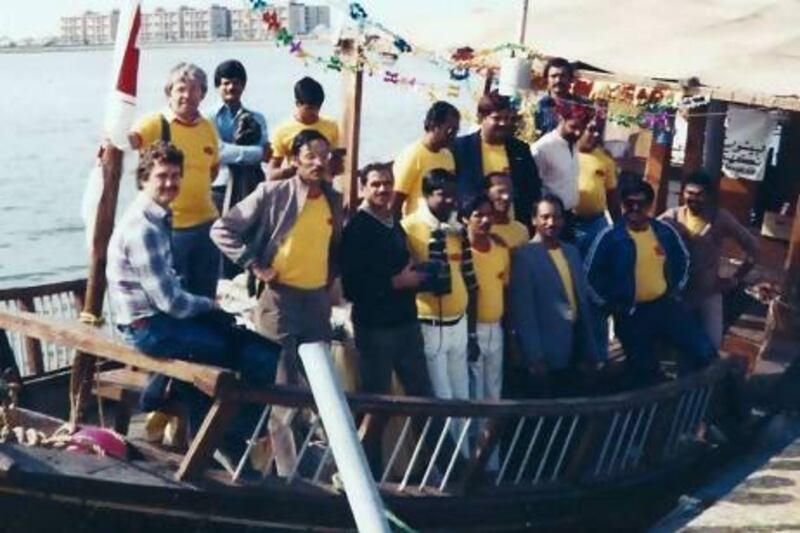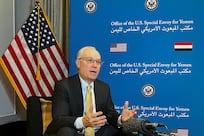When Lipton changed its television advertisement for Yellow Label tea in 1983 from one featuring a horseman in a desert oasis to another set in the Bahamas, the company’s containers of product were suddenly stopped at UAE ports.
Apparently – as former Lipton manager Deepak Tuleja later discovered – the director of Abu Dhabi customs had taken exception to the new advertisement and was refusing to allow the tea into the country until the old one was returned to the television.
“That’s how much of an iconic brand it had become,” says Mr Tuleja, who is retired and living in Canada. “He stopped our containers coming and said ‘me and my family want to see that advert back on Abu Dhabi television’. So we put it back on.”
Since the early 1980s, when it first arrived in the UAE, Lipton’s Yellow Label has become synonymous with tea, whether served with two green cardamom pods and a dash of Rainbow milk at a roadside cafe or poured from a china tea pot at a fancy restaurant.
Despite its British origins – it was first produced in 1890 by the Glaswegian merchant Sir Thomas Lipton – the Yellow Label brand is not promoted in the UK and is most popular in the Middle East and Asia.
The company has its second largest tea factory in the world in Jebel Ali free zone (the largest is in Manchester, England) and from there exports to 47 countries.
This is a far cry from the days when it was shipped from the UK in small quantities and salesmen tried to infiltrate a market that was new to the Lipton brand – and the tea bag.
Anil Mehra, 66, worked at Lipton in Dubai for most of the 1980s when the brand was still trying to make its mark.
“We had a big launch when I first arrived because of the cheap competition. There were copycats. That’s when we had to re-emphasise the quality,” he says.
The challenge wasn’t simply to introduce people to a new brand of tea – it was getting people to understand and trust the tea bag.
“When I came, the tea bags were only five or 10 per cent of the total market. It was a very small segment,” Mr Mehra says.
“People used to joke if I went in the souq, they would say ‘you’re drinking a sick tea bag, it has a bandage around it’.
“That’s why our first campaign was about going a long way to bring you quality. We wanted to reassure people that even in the tea bag, that tea was top quality.
“Two things that were challenging. One, they were used to long-leaf tea, and, second, it was packed in a different way.
“They weren’t brewing in a kettle then pouring it out – it was one tea bag per cup.”
To attract new customers, Mr Mehra, who now lives in Surrey, England, and his colleagues needed to hand out millions of samples to get people interested in the taste.
“We were using all means of sampling,” he says. “At social occasions in the British community, the Arab community and the Asian community, boys would go to set up the stations.
“We ran promotions with the tea shops where Emiratis went for shisha and to sit down and have a chat.”
Lipton, which has been part of the Unilever group since 1972, also ran reward programmes that offered people – specifically tea shop owners – the chance to claim a free air ticket home. It was the main incentive to encourage the owners to spend two or three times as much money on Lipton as the cheaper brands.
About 25 tickets were given out in Abu Dhabi each year.
“Everyone who got 10 tops of the boxes would get a box of tea for free and, at the end, we would give a free ticket to go to Kerala or Cairo, for example, for 1,000 tops. That used to be the currency,” Mr Mehra says.
“Households, restaurants and hotels, everyone was motivated to at least offer Lipton.
“We would train people in the tea shops how to make the tea in the proper way. In the Northern Emirates the quality of water wasn’t very good, brackish. We would tell them that they were wasting all their sugar and tea if they are not putting in the proper water. They would have to use better quality or install?filters.”
Although the tea shops played a large role, the team needed to encourage people to start drinking tea in the homes, which was still relatively uncommon.
A cup of tea in a tea shop cost about Dh1, so people were reluctant to spend Dh10 for 100 bags to make tea in their home, plus the cost of milk and sugar.
There was also a problem of counterfeit Lipton, most of it from Sri Lanka, which was sold cheaply in packets that, to the untrained eye, looked identical to Lipton Yellow Label.
At the time there were few laws protecting brands from copycats but Mr Mehra took the fight to the courts, where the judge questioned why he was so bothered by the counterfeiters.
“They said, why are you complaining, what’s the problem? This is tea and this is tea. Then I gave him the example. I said this tea is supplied by our distributors to royal homes and if there is a problem and someone becomes sick I will hold you responsible.”
Not surprisingly, sale of the counterfeit label stopped shortly after.
There are few official records available about products that were imported in the early days of the UAE and most that exist rely on anecdotal evidence.
It is not known exactly when or how Lipton Yellow Label was imported but by the early 1980s bosses saw enough potential in the Middle East market to set up an office in Dubai, which remains the regional hub.
Deepak Tuteja joined Lipton as a sales manager on July 28, 1983, his birthday. The company turnover was about Dh180 million, but grew to Dh450m during Mr Tuteja’s eight-year tenure.
Operating a business back then, he says, was a different world compared to how today’s multibillion dirham companies do business.
“The chairman of London exports would visit Abu Dhabi every six months,” Mr Tuteja says.
“Every time he visited my market he would go out with the salesmen and even to one or two tea shops.
“I had a salesman called Henry. He would ask him what ideas he had to draw the business.
“He would set Henry targets and, in those days there was telex, and he said, ‘every month you will tell me if you have achieved these targets’. It was a different world.”
The Lipton tea bag was the first in the UAE to carry individual brand tags. It was also the first in the world to carry brewing instructions on the printed tags, which were introduced in 1910.
Because of its distinctive bright yellow colour, the brand was able to make a visual impact – a great help for marketing.
“We realised that we could brand the cup and we realised the company that owned the tea shops would own the tea market,” Mr Tuteja says. “My job was to make sure we owned the tea shops.
“We did excellent displays, we helped them decorate. We had a lot of competition but we managed to throw them out.
“Everybody went to the tea shops, all sectors of society, right from the rich Arabs who would drive up in their Mercedes-Benz.
“Once they tasted the tea they would go home and demand the same.”
The intensive marketing has paid off and the company now holds about 70 per cent of the UAE market, with the most popular Lipton brand by a mile being Yellow Label.
“I know how the Arab consumers love Lipton. It is not by accident we have 70 per cent of the market share,’’ says Sanjiv Mehta, the chairman of Unilever in the Middle East and North Africa.
“If you look at tea bags, they are synonymous here with Lipton. Arab consumers don’t treat it as a foreign brand, they treat it as one of their own.
"Over the years the marketing of Lipton has resonated with the consumers. It was relevant to the previous generation, and it's relevant to the current generation."
munderwood@thenational.ae






